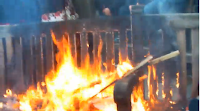My newspaper uses the conventions of a typical newspaper. I researched established newspapers such as The Sun, The Daily Mirror, The Daily Telegraph and also online news sites such as The Spoof and The Onion. I developed my ideas through taking different ideas from various newspapers. My newspaper is a newspaper but also has pastiche elements to it. It is aimed towards students 16-21 across Essex, I am not aware of any other student newspapers in this area so would be very unique. By using the codes and conventions from other well established newspapers I have been able to produce a professional look to my newspaper. Although the newspaperwill be pastiche in the layout it will also have humorous stories in it to make the students laugh. The newspaper would not only inform them of events and incidents going on at college and university but also include what is going on out of college/university such as clubs, festivals and other events. It would also include sporting news, and different reviews on things young people are interested in, such as clothing, video games, gadgets and the regulars in newspapers, such as puzzles and horoscopes. I have invented four original things for the newspaper which will make it stand out:
4. All the news in 20 sentences. A page that tells the students all the best story lines of the week in 20 sentences. Some stories
5. The newspaper 'The Onion' Has its own joke news channel which they broad cast humorous stories on their website. I think this is a good idea and w
I intend to produce a parody college/university newspaper for students aged 16-21 in Essex. The students I am aiming at will be interested in going out and colleg
How does my product differ?




What have you learned from your audience feedback?
How did you use new media technologies in the construction and research, planning and evaluation stages?















 At this point I changed the
At this point I changed the 
 It is only small next to the title however is effective in emphasising the catch phrase 'read something worth while for once'. The first story i wrote was about a
It is only small next to the title however is effective in emphasising the catch phrase 'read something worth while for once'. The first story i wrote was about a 


















